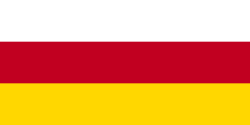Top Qs
Timeline
Chat
Perspective
Digor people
Ossetian subgroup From Wikipedia, the free encyclopedia
Remove ads
The Digor or West Ossetians (Ossetian: Дигорæнттæ, romanized: Digorænttæ,[5] pronounced [digɔːrɐ, digɔːrɐnttɐ]) are a subgroup of the Ossetians (Alans). They speak the Digor dialect of the Eastern Iranian Ossetian language, which in USSR, was considered a separate language until 1937. Since 1932, it has been considered just a dialect of Ossetian language. The speakers of the other dialect - Iron (East Ossetian) - do not understand Digor (West Ossetian), although the Digor usually understand East Ossetian, as it was the official language of the Ossetian people and was taught in schools. In the 2002 Russian Census 607 Digors were registered,[6] but by the 2010 Russian Census, their number had dropped to only 223.[7] It was estimated that there are 100,000 speakers of the dialect,[8] most of whom identify as Ossetians. The Digor mainly live in Digorsky, Irafsky, Mozdoksky districts and Vladikavkaz, North Ossetia–Alania, also in Kabardino-Balkaria and Turkey (Poyrazlı, Boğazlıyan).

Remove ads
Etymology
Scholars generally link the root dig- with the Circassian endonym A-dyg-e, where the suffix -or could be a mark of plurality as found in many contemporary Caucasian languages.[9][10] This point of view was criticized by R. Bielmeier and D. Bekoev, they raised the ethnonym to "tygwyr" in the Iron dialect, meaning "gathering, gathering, group."
History
Middle Ages
The early medieval Ashkharatsuyts makes mention of the "nation of the Ash-Tigor Alans" (azg Alanac' Aš-Tigor), or simply the "Dikor nation" (Dik'ori-n), which is generally regarded as an early reference to the Digor.[9][10] This fact, and other linguistic considerations, have led scholars to believe that Digor dialect became separated from Proto-Ossetian during the Mongol conquests.[citation needed]
Remove ads
Religion
Most Digors are Muslim. They were converted to Sunni Islam around the 17–18th centuries,[1] under the influence of the neighboring Kabarday people who introduced Islam to them.[11] Starting from the 18th century, the ethnonym digor became widely used by travelers and in Russian official documents. Digoria was annexed to the Russian Empire quite late compared to the rest of Ossetia. In the second half of the 19th century, large numbers of Muslim Digors emigrated to the Ottoman Empire.[citation needed]
Demographics
Digors make the majority of the Ossetians in Digoria, the western part of the North Ossetia–Alania (Digorsky and Irafsky districts), and in Kabardino-Balkaria. In the beginning of the 19th century, some families from Digoria resettled in Mozdoksky District, where they reside in the settlements of Novo-Osetinskaya and Chernoyarskaya.[12]
See also
Sources
- Wixman. The Peoples of the USSR, p. 58
References
Wikiwand - on
Seamless Wikipedia browsing. On steroids.
Remove ads

